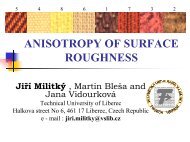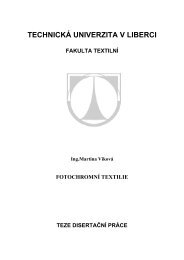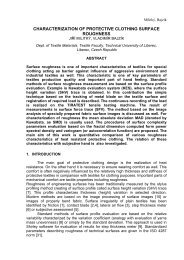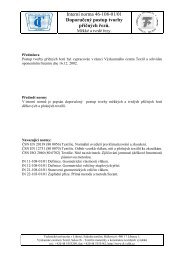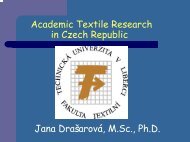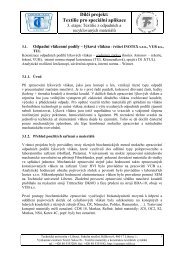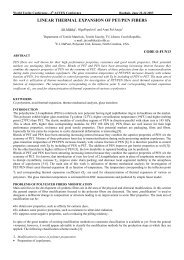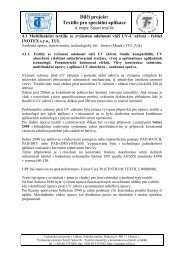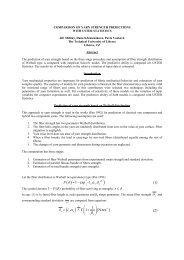Methods for Investigation of Yarn Structure and ... - Centrum Textil
Methods for Investigation of Yarn Structure and ... - Centrum Textil
Methods for Investigation of Yarn Structure and ... - Centrum Textil
You also want an ePaper? Increase the reach of your titles
YUMPU automatically turns print PDFs into web optimized ePapers that Google loves.
<strong>Methods</strong><br />
<strong>for</strong> investigation <strong>of</strong> yarn<br />
structure <strong>and</strong> properties<br />
Dana<br />
Kremenakova<br />
Technical University<br />
<strong>of</strong> Liberec<br />
<strong>Textil</strong>e Faculty<br />
<strong>Textil</strong>e research center<br />
Czech <strong>Textil</strong>e Seminar Greece May 2005
SYSTEM OF EXPERIMENTAL<br />
METHODS - Application<br />
• For quality evaluation <strong>of</strong> fibers, yarns,<br />
weaves, etc.<br />
• For verification <strong>of</strong> theoretical models,<br />
which describe structure <strong>and</strong><br />
properties <strong>of</strong> textiles<br />
• For evaluation material <strong>and</strong><br />
technological parameters <strong>of</strong> textiles<br />
• For technical design
Application<br />
<strong>of</strong> Image Analysis<br />
• Method selection<br />
• Sampling <strong>and</strong> sample<br />
preparation<br />
• Primary processing <strong>of</strong> image in<strong>for</strong>mation<br />
1. Image preprocessing (image enhancement,<br />
image restoration) elimination <strong>of</strong> signal noise, change<br />
<strong>of</strong> brightness<br />
2. Image analysis (image coding - compression)<br />
detection <strong>of</strong> lines, areas, shape in<strong>for</strong>mation,<br />
saving <strong>of</strong> data files<br />
• Secondary data treatment
Special<br />
methods<br />
• FIBERS<br />
Longitudinal views:<br />
identification, length, diameter (fibers<br />
with round pr<strong>of</strong>ile), surface faults<br />
Cross-sections:<br />
area, perimeter – computation <strong>of</strong><br />
fineness, shape factor, specific surface,<br />
degree <strong>of</strong> cottonization <strong>of</strong> ultimate flax<br />
fibers
Special methods<br />
YARNS<br />
Longitudinal views: hairiness, diameter,<br />
fiber slope, belt fibers <strong>of</strong> rotor yarn, cover<br />
factor <strong>of</strong> wrapped core yarn, yarn<br />
compression between two parallel plates,<br />
de<strong>for</strong>mation in simulated binding point<br />
Cross-sections: fiber<br />
number, packing density,<br />
diameter, porosity, blending<br />
uni<strong>for</strong>mity, mass (volume)<br />
blend portion
Special methods<br />
• FABRICS<br />
Longitudinal views: area geometry -<br />
cover factor, porosity, yarn diameter,<br />
surface faults<br />
Cross-sections: binding point geometry
Internal st<strong>and</strong>ards<br />
using existing ISO system<br />
IN 11-108-01/01 Definitions. Geometrical fiber properties.<br />
IN 12-108-01/01 Definitions. Geometrical properties <strong>of</strong> staple yarns.<br />
IN 21-108-01/01 Establishing <strong>of</strong> fiber geometrical properties.<br />
IN 21-108-02/01 Establishing <strong>of</strong> bast fibers cottonization degree.<br />
IN 22-102-01/01 <strong>Yarn</strong> diameter <strong>and</strong> hairiness.<br />
IN 22-103-01/01 <strong>Yarn</strong> packing density. Direct method <strong>and</strong> Secant<br />
method.<br />
IN 22-105-01/01 Belt fibers <strong>of</strong> open-end yarn.<br />
IN 23-107-01/01 Cover factor <strong>of</strong> fabrics.<br />
IN 46-108-01/01 Recommended procedure <strong>for</strong> preparation <strong>of</strong> sample<br />
cross-section. S<strong>of</strong>t <strong>and</strong> hard sections (slices).
No.<br />
I. <strong>Structure</strong> <strong>and</strong> properties <strong>of</strong><br />
100% cotton yarns [1]<br />
<strong>Yarn</strong> count [tex]/<br />
twist [m -1 ]/<br />
(coeff.) [m -1 ktex 2/3 ]<br />
Technology<br />
Fiber count [tex]/<br />
Length[mm]/<br />
Tenacity[cN/tex]<br />
1 10/1189 (60) Combed ring 0,148/30/34<br />
2 10/1232 (60) Combed experimental 0,148/30/34<br />
3 20/889 (65) Carded ring 0,196/25/19<br />
4 20/888 (65) Rotor 0,196/25/19<br />
5 20/802 (65) Carded experimental 0,196/25/19<br />
6 29,5/658 (65) Carded ring 0,183/25/20<br />
7 29,5/681 (65) Rotor 0,183/25/20<br />
8 29,5/652 (65) Carded experimental 0,183/25/20
Analysis <strong>of</strong> yarn cross-sections<br />
20 tex<br />
ring<br />
rotor<br />
experimental
METHODS FOR YARN PACKING DENSITY<br />
EVALUATION<br />
Direct method <strong>and</strong> Secant method [2], [3]<br />
INPUT DATA<br />
• Fiber fineness <strong>and</strong> mass density (<strong>for</strong> all<br />
components)<br />
• <strong>Yarn</strong> fineness <strong>and</strong> twist<br />
• Text files <strong>of</strong> fiber gravity<br />
centers (method Secant)<br />
• or graphical files <strong>of</strong> fiber<br />
contours (direct method)<br />
• Width <strong>of</strong> annular rings
EXPERIMENTAL METHODS<br />
FOR YARN PACKING DENSITY<br />
EVALUATION<br />
1. Input<br />
SECANT METHOD<br />
• fibers center <strong>of</strong> gravity<br />
detection<br />
DIRECT METHOD<br />
• detection <strong>of</strong> real fibers<br />
area<br />
• correction yarn crosssection<br />
images<br />
(separation,<br />
trans<strong>for</strong>mation to binary<br />
<strong>for</strong>m, noise removing)<br />
• fibers center <strong>of</strong> gravity<br />
computation
2. Computation<br />
SECANT METHOD<br />
• yarn axis definition<br />
• radial analysis<br />
• construction <strong>of</strong> equivalent<br />
circle<br />
• correction <strong>of</strong> non circularity<br />
caused by yarn twist<br />
• computation <strong>of</strong> packing<br />
density<br />
• correction <strong>for</strong> fiber migration<br />
- coefficient Ks<br />
DIRECT METHOD<br />
• yarn axis definition<br />
• radial analysis<br />
• computation <strong>of</strong> packing<br />
density
3. Output<br />
SECANT METHOD<br />
DIRECT METHOD<br />
<strong>for</strong> single yarn <strong>and</strong> blended yarn<br />
radial packing density<br />
effective yarn diameter<br />
effective yarn packing density<br />
fiber number in yarn cross-section<br />
coefficients <strong>of</strong> fiber arrangement<br />
only <strong>for</strong> blended yarn<br />
mass blend portion as a function <strong>of</strong> distance from<br />
yarn center
Radial packing density →<br />
effective yarn diameter – radial packing density 0,15<br />
effective packing density – fiber cross-sec. area<br />
/whole yarn cross-sec. Area (circle with diameter d )<br />
0,4<br />
0,35<br />
d = 4T<br />
πµρ<br />
packing density [1]<br />
0,3<br />
0,25<br />
0,2<br />
0,15<br />
0,1<br />
0,05<br />
0<br />
0,01 0,04 0,07 0,1 0,13 0,16 0,19 0,22 0,25 0,28<br />
d/2<br />
yarn radius [mm]
NUMBER OF FIBRES IN YARN CROSS-<br />
SECTION<br />
n=k n * yarn fineness/fiber fineness<br />
ring<br />
rotor<br />
experimental<br />
[tex]
RADIAL PACKING DENSITY<br />
packing density [-]<br />
0,7<br />
0,6<br />
0,5<br />
0,4<br />
0,3<br />
0,2<br />
0,1<br />
0<br />
1. ring 10 tex<br />
2. experimental 10 tex<br />
3. ring 20 tex<br />
4. rotor 20 tex<br />
5. experimental 20 tex<br />
6. ring 29,5 tex<br />
7. rotor 29,5 tex<br />
8. experimental 29,5<br />
0 0,04 0,08 0,12 0,16 0,2 0,24 0,28<br />
yarn radius [mm]
Radial<br />
packing density<br />
packing density [1]<br />
0,8<br />
0,6<br />
0,4<br />
0,2<br />
0<br />
65%PET/35% bavlna<br />
0,01 0,03 0,05 0,07 0,09 0,11 0,13 0,15 0,17 0,19<br />
ring 25 tex,<br />
640/m<br />
rotor<br />
25 tex,940/m<br />
yarn radius [mm]<br />
0,6<br />
the same twist<br />
0,6<br />
0,5<br />
higher twist<br />
<strong>of</strong> rotor yarn<br />
packing density [ ]<br />
0,5<br />
0,4<br />
0,3<br />
0,2<br />
0,1<br />
20 tex<br />
radiální zaplnění [ ]<br />
0,4<br />
0,3<br />
0,2<br />
0,1<br />
0<br />
detail<br />
0 0,02 0,04 0,06 0,08 0,1 0,12 0,14 0,16 0,18 0,2 0,22 0,24 0,26<br />
poloměr příze [mm]<br />
0<br />
0,00 0,04 0,08 0,12 0,16 0,20 0,24 0,28<br />
ring experimental rotor<br />
yarn radius [mm]
EFFECTIVE PACKING DENSITY<br />
EFFECTIVE YARN DIAMETER<br />
ring<br />
rotor<br />
experimental<br />
[mm]<br />
d = 4T<br />
πµρ<br />
[tex]
YARN HAIRINESS<br />
10 tex<br />
29,5 tex<br />
20 tex
Definition<br />
Hairiness - characterizes the amount <strong>of</strong> free<br />
fibers (fiber loops) protrudes from the<br />
compact yarn body towards the outer yarn<br />
surface (fabric, knittings, etc.)<br />
Evaluation criteria –<br />
number <strong>of</strong> free fibers<br />
(length <strong>and</strong> area units)
Measurement<br />
<strong>of</strong> yarn hairiness<br />
1. Zellweger hairiness meter USTER-<br />
TESTER 4-scanning <strong>of</strong> light intensity <strong>of</strong><br />
illuminated fibers, hairiness index H total<br />
length <strong>of</strong> all fibers protruding from the yarn<br />
body, which are measured on the 1 cm yarn<br />
length<br />
2. Zweigle hairiness tester – photo-electric<br />
sensors, number <strong>of</strong> fibers protruding from<br />
the yarn body, 12 classes
3. YARN HAIRINESS<br />
<strong>and</strong> YARN DIAMETER<br />
[4]<br />
Line <strong>of</strong><br />
pixels<br />
• Light rays passing trough<br />
yarn<br />
• Recognition between<br />
yarn body <strong>and</strong> hairiness<br />
area<br />
• Model <strong>of</strong> „dense” <strong>and</strong><br />
„thin” hairiness<br />
• Experimental curve<br />
related to frequency <strong>of</strong><br />
occurring black pixels as<br />
a function <strong>of</strong> distance<br />
from yarn axis
Hairiness function<br />
<strong>Yarn</strong> diameter - 50% <strong>of</strong> hairiness function<br />
Constant value – integral under hairiness<br />
function in interval (D/2;3*D)<br />
1,2 3,4,5 6,7,8<br />
Ring/experimental/rotor<br />
R1
Hairiness USTER<br />
<strong>Yarn</strong> hairiness<br />
Hairiness TUL<br />
ring<br />
rotor<br />
experimental<br />
[tex]
<strong>Yarn</strong> unevenness<br />
Irregularity index<br />
[%]<br />
ring<br />
rotor<br />
experimental<br />
CVlim = 100<br />
n e<br />
I<br />
=<br />
CV<br />
Uster<br />
CV lim<br />
[tex]<br />
Martindale equation
[%]<br />
<strong>Yarn</strong> tenacity<br />
elongation<br />
fiber utilization fact.<br />
[N/tex]<br />
ring<br />
rotor<br />
experimental<br />
[tex]
Conclusion 1:<br />
Influence <strong>of</strong> fineness <strong>and</strong> technology<br />
100% cotton ring yarns, experimental <strong>and</strong><br />
rotor yarns<br />
neps +200% 350<br />
thick +50% 300<br />
250<br />
thin -40% 200<br />
150<br />
uneveness index 100<br />
50<br />
0<br />
CV Uster<br />
yarn elongation<br />
FUF<br />
yarn tenacity<br />
hairiness Uster<br />
fiber fineness<br />
fiber length<br />
fiber tenacity<br />
yarn fineness<br />
twist coefficient<br />
yarn twist<br />
fiber number<br />
yarn diameter<br />
packing density<br />
hairiness TUL<br />
10 tex ring<br />
10 tex experimental<br />
20 tex ring<br />
20 tex experimental<br />
20 tex rotor<br />
29,5 tex ring<br />
29,5 tex experimental<br />
29,5 tex rotor
No.<br />
II. 100% Cotton Ring<br />
<strong>and</strong> Compact <strong>Yarn</strong>s<br />
[5]<br />
<strong>Yarn</strong> count [tex]/<br />
twist [m -1 ]/<br />
(coeff.) [m -1 ktex 2/3 ]<br />
Technology<br />
Fiber count [tex]/<br />
Length[mm]/<br />
Tenacity[cN/tex]<br />
1 7,4/1307 (50) ring 0,146/29/40<br />
2 7,4 /1262 (50) compact 0,148/29/31<br />
3 11,8 /1066 (55) ring 0,196/29/39<br />
4 20/1059 (55) compact 0,196/29/34<br />
5 20 /944(70) ring 0,183/29/22<br />
6 29,5/977 (70) compact 0,183/29/23
RADIAL PACKING DENSITY<br />
compact <strong>and</strong> ring yarn7,4 tex, 100% cotton,<br />
twist ring 1307/m, compact 1262/m<br />
Radial packing density [-]<br />
0,6<br />
0,5<br />
0,4<br />
0,3<br />
0,2<br />
0,1<br />
0<br />
Compact FUF 65% H 2,8 Ring FUF 38%, H4,1<br />
0 0,02 0,04 0,06 0,08 0,1 0,12<br />
<strong>Yarn</strong> radius [mm]
compact<br />
ring<br />
PACKING<br />
DENSITY<br />
RADIAL<br />
AND<br />
EFFECTIVE<br />
Radial pack ing dens ity [-<br />
]<br />
0,6<br />
0,5<br />
0,4<br />
0,3<br />
0,2<br />
0,1<br />
0<br />
0 0,03 0,06 0,09 0,12 0,15 0,18<br />
<strong>Yarn</strong> radius [mm]<br />
0,48<br />
20 tex<br />
Radial pack ing dens ity [-]<br />
0,7<br />
0,6<br />
0,5<br />
0,4<br />
0,3<br />
0,2<br />
0,1<br />
0<br />
compact<br />
ring<br />
11,8 tex<br />
0 0,02 0,04 0,06 0,08 0,1 0,12 0,14<br />
<strong>Yarn</strong> radius [mm]<br />
packing density [-]<br />
0,47<br />
0,46<br />
0,45<br />
0,44<br />
0,43<br />
0,42<br />
C<br />
C<br />
5 10 15 20<br />
yarn fineness [tex]<br />
C
HAIRINESS<br />
yarn diameter [-]<br />
0,19<br />
0,18<br />
0,17<br />
0,16<br />
0,15<br />
0,14<br />
0,13<br />
0,12<br />
0,11<br />
0,10<br />
0,09<br />
C<br />
C<br />
5 10 15 20<br />
yarn fineness [tex]<br />
C<br />
R1
0,024<br />
0,022<br />
0,020<br />
HAIRINESS<br />
TUL<br />
HAIRINESS<br />
USTER<br />
hairiness TUL<br />
0,018<br />
0,016<br />
0,014<br />
0,012<br />
0,010<br />
0,008<br />
3 3 4 4 5 5 6<br />
hairiness Uster<br />
0,024<br />
0,022<br />
hairiness TUL [-]<br />
0,020<br />
0,018<br />
0,016<br />
0,014<br />
0,012<br />
0,010<br />
0,008<br />
C<br />
C<br />
5 C 10 15 20<br />
hairiness Uster [-]<br />
5,50<br />
5,00<br />
4,50<br />
4,00<br />
3,50<br />
3,00<br />
2,50<br />
5 10 15 20<br />
yarn fineness [tex]<br />
yarn fineness [tex]
tenacity [cN/tex]<br />
0,24<br />
0,23<br />
0,22<br />
0,21<br />
0,20<br />
0,19<br />
0,18<br />
0,17<br />
0,16<br />
0,15<br />
TENACITY<br />
ELONGATION<br />
FIBER<br />
UTILITY<br />
FACTOR<br />
C<br />
C<br />
5 10 15 20<br />
elongation [%]<br />
yarn fineness [tex]<br />
6,00<br />
5,50<br />
5,00<br />
4,50<br />
4,00<br />
3,50<br />
C<br />
5 0,75 10 C 15 20<br />
0,70 C<br />
yarn fineness [tex]<br />
0,65<br />
C<br />
FUF [%]<br />
0,80<br />
0,60<br />
0,55<br />
0,50<br />
0,45<br />
0,40<br />
0,35<br />
0,30<br />
C<br />
C<br />
5 10 15 20<br />
yarn fineness [tex]<br />
C
Conclusion 2:<br />
Influence <strong>of</strong> fineness <strong>and</strong> technology<br />
100% cotton ring yarns <strong>and</strong> compact yarns<br />
fiber fineness<br />
neps +200% 250 fiber length<br />
thick +50% 200 fiber tenacity<br />
thin -40% 150<br />
100<br />
fiber elongation<br />
uneveness index<br />
CV Uster<br />
50<br />
0<br />
yarn fineness<br />
yarn twist<br />
yarn elongation<br />
FUF<br />
yarn tenacity<br />
hairiness Uster<br />
fiber number<br />
yarn diameter<br />
packing density<br />
hairiness TUL<br />
7,4 tex ring<br />
7,4 tex compact<br />
11,8 tex ring<br />
11,8 tex compact<br />
20 tex ring<br />
20 tex compact
III. <strong>Structure</strong> <strong>and</strong> properties<br />
<strong>of</strong> blended yarns [6]<br />
50% cotton / 50% flax yarns<br />
No.<br />
<strong>Yarn</strong> count [tex]/<br />
twist [m -1 ]/<br />
(coeff.) [m -1 ktex 2/3 ]<br />
Technology<br />
1 24/968(81) 45%cotton/55%flax<br />
ring<br />
2 24 /981 (83) 50%cotton/50%flax<br />
experimental<br />
3 24/1261 (105) 50%cotton/50%flax<br />
rotor<br />
Fiber count [tex]/<br />
Length[mm]/<br />
Tenacity[cN/tex]<br />
Co 0,176/22/32<br />
Flax 0,336/23/40<br />
Co 0,173/32/34<br />
Flax 0,376/29/50<br />
Co 0,173/32/34<br />
Flax 0,376/29/50
Flax fiber separation [7]<br />
Parallel fiber cross–sections<br />
be<strong>for</strong>e cottonization (left) after cottonization (right),<br />
reflected light, electron microscope Aquasem
e lative fre que ncy [-]<br />
relative frequency [-]<br />
Relative frequency <strong>of</strong> fibers bundles occurrence<br />
Histogram <strong>of</strong> fiber fineness<br />
Correlation between number <strong>of</strong> fibers in bundle <strong>and</strong><br />
bundle fineness [7]<br />
0,6<br />
0,4<br />
0,2<br />
0<br />
0,3<br />
0,25<br />
0,2<br />
0,15<br />
0,1<br />
0,05<br />
0<br />
1 2 3 4 5 6 7 8 9 10<br />
number <strong>of</strong> fibers in bundle [-]<br />
0,1 0,3 0,5 0,7 0,9 1,1 1,3 1,5<br />
fiber fineness [tex]<br />
bundle fineness [tex]<br />
12<br />
10<br />
8<br />
6<br />
4<br />
2<br />
0<br />
experiment<br />
regression<br />
0 10 20 30<br />
number <strong>of</strong> fibers in bundle [-]
Distribution function <strong>of</strong> fibers bundles<br />
1<br />
distribution function<br />
0,9<br />
0,8<br />
0,7<br />
0,6<br />
0 5 10 15 20 25 30 35 40 45<br />
number <strong>of</strong> fiber bundle<br />
1. original tow<br />
3.enzymatic tr.<br />
3F. mechanical tr.<br />
F1 separation<br />
R10 =100(1-F10) aggregation
Typical yarn cross-section <strong>of</strong><br />
50% cotton/50% cottonized flax yarn<br />
packing density [-]<br />
1<br />
0,9<br />
0,8<br />
0,7<br />
0,6<br />
0,5<br />
0,4<br />
0,3<br />
0,2<br />
0,1<br />
0<br />
direct<br />
direct<br />
Secant<br />
Secant<br />
0 0,02 0,04 0,06 0,08 0,1 0,12 0,14 0,16 0,18 0,2<br />
yarn radius [mm]
RADIAL PACKING DENSITY<br />
yarns 24 tex, 50%cotton/50% cot. flax, twist experimental<br />
981/m, ring 968/m, rotor 1261/m<br />
0,7<br />
experimental FUF 28% H7,5<br />
ring FUF 34% H8,1<br />
rotor FUF 21% H8,0<br />
0,6<br />
packing density [-]<br />
0,5<br />
0,4<br />
0,3<br />
0,2<br />
0,1<br />
0<br />
0 0,02 0,04 0,06 0,08 0,1 0,12 0,14 0,16 0,18 0,2<br />
yarn radius [mm]
50%cotton/50%flax<br />
ring, rotor, experimental<br />
yarn 24 tex<br />
co exp fl exp co ring<br />
fl ring co rotor fl rotor<br />
0,8<br />
packing density [-]<br />
0,7<br />
0,6<br />
0,5<br />
0,4<br />
0,3<br />
0,2<br />
0,1<br />
hmotnostní podíl [-<br />
0,7<br />
0,6<br />
experimental ring 0,5 rotor<br />
0,4<br />
0,3<br />
0,2<br />
0 0,02 0,04 0,06 0,08 0,1 0,12 0,14<br />
polomě r [mm]<br />
0<br />
0 0,02 0,04 0,06 0,08 0,1 0,12 0,14 0,16 0,18 0,2<br />
dameter [mm]
50%cotton/50%flax<br />
ring, rotor, experimental<br />
yarn 24 tex<br />
100<br />
experimental ring rotor<br />
funkce chlupatosti [%]<br />
80<br />
60<br />
40<br />
20<br />
0<br />
0,00 0,05 0,10 0,15 0,19 0,24 0,29 0,34<br />
poloměr příze [mm]
Properties <strong>of</strong> cotton-flax yarn<br />
ring experimental rotor<br />
Mass ratio Co/flax 35/65 40/60 46/54<br />
Eff. Diameter [mm] 0,19 0,17 0,20<br />
Eff. packing d. [mm] 0,40 0,42 0,34<br />
Hairiness TUL/Uster 0.022/7,84 0,023/7,36 0,023/7,89<br />
Tenacity [cN/tex] 0,13 0,11 0,08<br />
Elongation [%] 4,19 3,07 3,14<br />
CV [%] 24,35 29,23 23,12<br />
Thin -40% [km-1] 3088 6903 3813<br />
Thick +50% [km-1] 1868 3375 1875<br />
Neps +200% [km-1] 643 2335 2350
BLENDING QUALITY<br />
mixing homogeneity <strong>for</strong> natural <strong>and</strong> synthetic<br />
fibers or separation <strong>of</strong> components <strong>for</strong> core<br />
yarns, wrapped yarns<br />
• Arrangement <strong>of</strong> fibers in the crosssection<br />
– radial homogeneity<br />
• Variation <strong>of</strong> mixing degree or<br />
composition between cross-section<br />
– axial homogeneity<br />
• Variation <strong>of</strong> fiber number between<br />
cross-sections – mass unevenness
Testing <strong>of</strong> fiber bundles presence<br />
• <strong>Yarn</strong> cross-section is divided to matrix<br />
<strong>of</strong> cells - I.B.I. (index <strong>of</strong> blend<br />
irregularity)<br />
• Creation <strong>of</strong> sequences <strong>of</strong> nearest<br />
neighbors <strong>of</strong> the specified fiber – fiber<br />
nearest to yarn center, exhaustive<br />
selection <strong>of</strong> all fibers in yarn crosssection
I.B.I. Index <strong>of</strong> blend irregularity<br />
Local <strong>and</strong> global estimates <strong>of</strong> probabilities , χ2 test<br />
m-number <strong>of</strong> cells, N i<br />
- fiber number in i-th cell; α 1<br />
=N 1<br />
/N, etc.<br />
m<br />
2 m<br />
2<br />
( N −α<br />
N ) ( N −α<br />
N )<br />
χ =<br />
∑<br />
1i<br />
α N<br />
i=<br />
1 1<br />
N 1i<br />
+ N 2i<br />
= N i<br />
; α 1<br />
+α 2<br />
=1<br />
2<br />
χ =<br />
m<br />
∑<br />
α<br />
2<br />
1<br />
1<br />
+<br />
∑<br />
2i<br />
α<br />
i=<br />
1 2<br />
2<br />
2 m<br />
( N −α<br />
N ) + α ( N −α<br />
N ) ( N −α<br />
N )<br />
1i<br />
i=<br />
1 1 2<br />
I.B.I.<br />
=<br />
1<br />
α α<br />
2<br />
N<br />
2i<br />
2<br />
=<br />
m<br />
1 N −<br />
∑<br />
1i<br />
1<br />
m<br />
i=<br />
1<br />
α1α<br />
2<br />
N<br />
2<br />
∑<br />
1i<br />
α α N<br />
i=<br />
1 1 2<br />
( α )<br />
N<br />
N<br />
2<br />
1<br />
2
Cross-sec no. 2 good, no. 3 bad<br />
Good<br />
Bad
1,35<br />
I.B.I.<br />
1,25<br />
1,15<br />
1,05<br />
0,95<br />
0,85<br />
rectangular<br />
rectangular<br />
radial<br />
radial<br />
pie segment<br />
pie segment<br />
0,75<br />
0 1 2 3 4<br />
“Good” arr.<br />
cross-section<br />
n.2<br />
“Bad” arr.<br />
cross-section<br />
n.3<br />
Ring spun<br />
yarn<br />
24 tex<br />
Exper. yarn<br />
24 tex<br />
Open-end<br />
yarn<br />
24 tex<br />
I.B.I.<br />
rectangular<br />
matrix [-]<br />
0,58 1,93<br />
1,02<br />
(0,86;1,19)<br />
0,98<br />
(0,88;1,09)<br />
1,08<br />
(0,91;1,26)<br />
I.B.I. radial<br />
segments [-] 0,42 2,56<br />
1,04<br />
(0,80;1,28)<br />
0,93<br />
(0,79;1,06)<br />
1,05<br />
(0,85;1,26)<br />
I.B.I. annular<br />
segments[-] 0,96 1,74<br />
1,25<br />
(1,13;1,36)<br />
0,98<br />
(0,83;1,13)<br />
1,23<br />
(1,10;1,35)<br />
I.B.I.<br />
Between<br />
cross-sec.[-]<br />
- - 1,55 1,92 1,44
Experimental relative frequencies <strong>of</strong><br />
occurrence <strong>of</strong> fibrous bundles<br />
1.<br />
2.<br />
3.<br />
4.<br />
5.<br />
6.<br />
.<br />
.<br />
.<br />
1. 2. 3.<br />
<strong>Yarn</strong> n. 2 50PET/50cotton 35 tex<br />
H<br />
R exp<br />
R teor
Distribution <strong>of</strong> total number sequences<br />
• Configuration – fully specified arrangement <strong>of</strong> fibers in the<br />
cross-section to sequence according to specified criterion<br />
• Sequence – set <strong>of</strong> fibers <strong>of</strong> one selected component<br />
• Sequence length – number <strong>of</strong> fibers in tis set<br />
• Total number <strong>of</strong> sequences – <strong>for</strong> individual components<br />
is valid ⏐ S 1<br />
-S 2<br />
⏐ = 1or S 1<br />
= S 2<br />
• Limit configuration – limit aggregation (fiber <strong>of</strong> each<br />
component are creating one sequence only ), limit<br />
segregation (fiber <strong>of</strong> both components are regularly<br />
alternated )
Distribution <strong>of</strong> total number sequences<br />
4,5<br />
4<br />
A<br />
B<br />
A B C D E<br />
3,5<br />
3<br />
2,5<br />
2<br />
D<br />
C<br />
C C A C C<br />
D A D A D<br />
B E E E B<br />
1,5<br />
1<br />
0,5<br />
0<br />
0 1 2 3 4 5<br />
E<br />
E D B B A<br />
1 1 1 1 2 S1<br />
1 2 1 2 2 S2<br />
2 3 2 3 4 S
Ising-Stevens distribution<br />
⎛ N<br />
P( ∑ = S ) 1 1<br />
= ⎜<br />
⎝ S<br />
1<br />
1<br />
− 1⎞<br />
⎛<br />
⎟⎜<br />
− 1⎠⎝<br />
N<br />
N<br />
2<br />
− 1<br />
+ 1−<br />
S<br />
⎞<br />
⎟<br />
⎠<br />
⎛<br />
⎜<br />
⎝<br />
N<br />
N<br />
2 1 1<br />
⎞<br />
⎟<br />
⎠<br />
• Mean value E(S) <strong>and</strong> variance D(S) <strong>of</strong> total number sequences S<br />
( ) ES<br />
= +<br />
NN<br />
1 2 1 2<br />
( ) ( )<br />
2<br />
DS = 2N N 2NN − N N ( N−1)<br />
N<br />
1 2 1 2<br />
• For a large value <strong>of</strong> N, the distribution <strong>of</strong> total number <strong>of</strong> sequences<br />
S can be approximated by normal one having parameters E(S), D(S).<br />
Total number <strong>of</strong> sequences can be then trans<strong>for</strong>med to st<strong>and</strong>ardized<br />
r<strong>and</strong>om variable Z with normal distribution N(0,1).<br />
Z<br />
=<br />
S<br />
( )<br />
− E S ±05 ,<br />
( )<br />
DS
Z values<br />
Distribution <strong>of</strong> total<br />
number sequences<br />
Ring –4,67<br />
Z<br />
Experimental -7,01<br />
Cross - sec.n.<br />
Z<br />
Rotor –0,57<br />
Cross - sec.n.<br />
Z<br />
Z
Conclusion III<br />
50%cotton/50%flax<br />
ring, rotor, experimental<br />
yarn 24 tex<br />
cotton<br />
flax<br />
Fiber<br />
properties<br />
elongation co/flax 6/4%<br />
length co/flax 30/28mm<br />
300<br />
200<br />
100<br />
fineness co/flax<br />
0 +<br />
0,17/0,37tex<br />
tenacity co/flax<br />
0,34/0,49N/tex<br />
+ Pressley<br />
0,39N/tex
Conclusion III<br />
50%cotton/50%flax<br />
ring, rotor, experimental yarn 24 tex<br />
neps +200%<br />
thick places +50%<br />
thin places -40%<br />
uneveness index<br />
fineness<br />
300<br />
250<br />
200<br />
150<br />
100<br />
50<br />
0<br />
twist<br />
ring<br />
experimental<br />
rotor<br />
fiber number<br />
diameter<br />
packing density<br />
CV Uster<br />
hairiness TUL<br />
elongation<br />
fiber utility factor<br />
hairiness Uster<br />
tenacity
References<br />
Thank you<br />
<strong>for</strong> your<br />
attention<br />
[1] Křemenáková, D., Militký, J.: Influence <strong>of</strong> production technology on the cotton yarn<br />
properties. Beltwide Cotton Utilization Conference, San Antonio, USA, January 2004.<br />
[2] Neckář, B.: <strong>Yarn</strong>s,. creation, structure, properties. SNTL Praha 1990. in Czech.<br />
[3] Křemenáková, D.: IN 22-103-01/01 <strong>Yarn</strong> packing density. Direct method <strong>and</strong> Secant<br />
method.<strong>Textil</strong>e research Center <strong>Textil</strong>e. Technical university <strong>of</strong> Liberec 2002.<br />
[4] Neckář, B., Voborová, J.: A new Approach <strong>for</strong> Determination <strong>of</strong> <strong>Yarn</strong> hairiness. 3 d<br />
Autex conference, Necessary Condition <strong>for</strong> Development <strong>of</strong> Civilization, June 2003<br />
Gdansk, Pol<strong>and</strong>.<br />
[5] Nováčková, J.,Křemenáková, D.: Structural analysis <strong>of</strong> fine coton yarns. 10th<br />
International conference Strutex 2003. <strong>Structure</strong> <strong>and</strong> structural mechanics <strong>of</strong> textiles.<br />
Technical University <strong>of</strong> Liberec, CZ.<br />
[6] Křemenáková, D., Ibrahim, S., Krupincová, G.: Internal <strong>Structure</strong> <strong>of</strong> Blended Flax<br />
<strong>Yarn</strong>s, International Conference Flax <strong>and</strong> Allowed Fiber Plants <strong>for</strong> Human Welfare,<br />
December 2003, NRC Cairo, Egypt.<br />
[7] Křemenáková, D.,Militký, J., Antonov, V.: Cottonization degree <strong>of</strong> pretreated flax<br />
fibers. Vlákna a textil 10 (2), 82-85, 2003.



